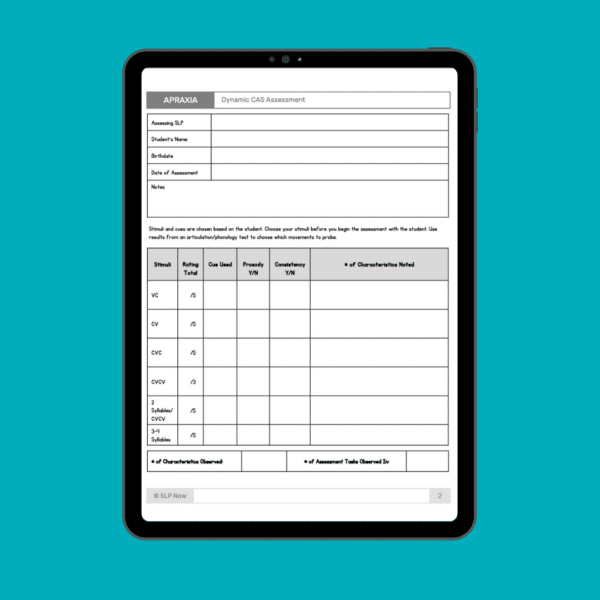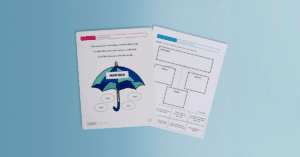This is a guest blog post by Monica, a school-based SLP, all about treating childhood apraxia of speech (CAS).
Childhood Apraxia of Speech (CAS)
Treating childhood apraxia of speech (CAS) can feel overwhelming. There is a lot to know, but there is a wealth of information available.
When it comes down to it, CAS is a motor speech disorder that’s under the umbrella of speech sound disorders (SSD), so we have to treat it differently than other speech sound disorders by concentrating on motor planning. You’ll hear motor planning a lot when you look up information about CAS, and you’ll have to shift your thinking from working on individual “speech sounds” to working on “speech movements.” CAS requires frequent sessions with a lot of trials to remediate. During those sessions, you’ll use principles of motor learning and an approach that’s the right fit for your student.
This post will give you an overview of the resources available to SLP Now members.
> If you’re a member, click here to access the materials!
> If you’re not a member yet, click here to sign up for a free trial. The trial includes 5 free downloads, and it’s totally risk-free! No credit card required. 🙂
Keep in mind that this is a very simplified version of treatment for childhood apraxia of speech, and I encourage you to seek out additional training if you are going to be treating students with CAS.
Dynamic Assessment
Dynamic assessment is a crucial first step to treatment because you’ll figure out what stimulus set to start with, as well as what type of cueing and feedback work for your student.
This assessment will include a variety of syllable shapes to see what movements are difficult for your student. Think CV, VC, CVC, CVCV, and multisyllabic words. The emphasis isn’t on what sounds are being produced but where the breakdown is happening in your student’s motor plan. They may produce a CV, but not a CVC. That lets us know that adding that extra consonant is difficult.
During the assessment, you’ll also be looking out for ten different characteristics of CAS. Strand and McCauley (2018) state that having four characteristics over three assessment tasks indicates CAS.
Here’s a preview of our informal CAS dynamic assessment that’s a part of our CAS skill pack available to SLP Now members. The assessment is based on Dr. Strand’s work through the Callier Center for Communication Disorders at UT Dallas. The free training is available at this link.
We’ve included a page for differential diagnosis with other speech sound disorders, a research summary with all of the important terms, and apraxia “do’s and don’ts.”
Apraxia Do’s and Don’ts
Here are a few examples:
>> Do suggest AAC if your student has a severe speech sound disorder and has difficulty communicating.
>> Do collaborate with the student and parents to pick meaningful stimuli words.
xx Don’t forget about co-occurring diagnoses and take that into account when you are planning treatment (a phonological disorder is most likely going to be co-occurring).
xx Don’t segment sounds as you say them (e.g., break up bat into /b/ /at/). This will disrupt the motor plan. You want the student to learn to make a continuous motor movement.
How to Choose Your Initial Stimulus Set for CAS
Use your clinical skills to choose your first set.
In her training, Dr. Strand walks you through how to use your clinical skills to choose your first set. There are no easy, ready-made sets because they need to be individualized for each student. For students with severe CAS, you’ll pick a small stimulus set that includes difficult movements for them to produce. In the beginning, you’ll use very specific feedback about how to make the movements (knowledge of performance), and feedback will be very frequent.
Later, you’ll move to a larger stimulus set once students are more successful and have more feedback about if their production was correct (knowledge of results) and also have less feedback overall. I like to incorporate a lot of self-monitoring in the later stages for generalization.
Going through the dynamic assessment will help you choose your initial stimulus set based on what movements students were successful with and what type of cueing helped them produce movements that they could not do on their own.
It’s also crucial to choose words that are important to your student and their family to get early success and buy-in.
Before Your Sessions Start
Figure out what type of method you’re going to use with your students.
Here are moderately strong to very strong evidence-backed treatment methods with free training or information available:
Dynamic Temporal and Tactile Cueing DTTC (Developed by Edythe Strand) → Moderate severe CAS (ages two and up)
ReSt/TEMPO (Developed by Speech Pathology in the Sydney School of Health Sciences at the University of Sydney headed by Professor Tricia McCabe) → CAS and ataxic dysarthria (ages 4-12)
Integrated Phonological Awareness Training (Moriarty & Gillon, 2006) → Speech-language impairment (ages 4-12)
The NDP3 program (Williams & Stephens, 2004) is also evidence-backed but not free. Students must have attention skills, the ability to imitate (look at the clinician’s face), and knowledge of cues before they can begin CAS treatment.
I love using DTTC and have had a lot of great success with it over the years. It utilizes principles of motor learning that I honestly use with all of my speech sound disorder students.
We’ve got a great guide with activities to help gauge your student’s skills. You can use play-based sessions to gauge these skills and use that opportunity to build a relationship. You can also introduce words you’ll be using for cueing and feedback. Also, make sure your students are ready for your sessions by taking an inventory of their attention and imitation skills.
It’s also an opportunity to see if the method you chose is a great fit. DTTC works well, but it requires a lot of sustained attention to look at the SLPs face. DTTC may not be the best choice for autistic students if you can’t find a workaround.
Ideas for Sessions
If you’re using DTTC, we (SLP Now) have a guide in our skill pack to help!
The quick rundown is that it’s a cueing system to start with the most help for your student’s motor plan (saying the stimulus simultaneously) and then move to the least support for their motor planning (spontaneous). It’s easy once you get the hang of it. You’ll most likely find that it’s helpful for your entire speech sound disorder caseload.
“Principles of motor learning” is another term that you’ll hear a lot about with CAS.
The best way to summarize it is that they are principles that, when followed, improve a student’s motor plan in efficiency and flexibility. Some of the significant points are:
1. Practice as much as you can.
2. Build a relationship with the student.
3. The student should have clear instructions and know what to expect.
4. Vary distribution of practice with the child’s progress and severity.
5. Work on prosody.
6. Use a slow rate to help with motor planning.
7. Vary feedback based on the student’s performance.
In this podcast episode, Amy Graham of Graham Speech Therapy talks about treating CAS and the principles of motor learning. She also talks about how you don’t need anything fancy for therapy sessions to work on CAS.
Her Instagram account has lots of videos of her doing therapy, which are helpful to watch! She likes quick games that get a lot of trials.
Dr. Strand also notes that pictures and cards should not be used when you are first starting treatment because you want the emphasis to be on your face so that the student can get that input for their motor planning.
As long as you can get a lot of trials, anything can work! Here are some other ideas for sessions that I pulled from our skill pack:
1. Use a racetrack and send a car down for every ten trials.
2. Have mystery paper bags that students get to open after ten trials.
3. Have plastic eggs that students get to open after ten trials.
Resources
Here are some other resources that I’ve found to be helpful:
Instagram
Carie Ebert – SLP Apraxia Specialist
SLP Mommy of Apraxia – SLP Apraxia Specialist
Free Training
Presented by Edythe Strand in partnership with Callier Center for Communication Disorders UT Dallas
YouTube videos on assessment, treatment, and DTTC
ReST
Integrated Phonological Awareness Training
Free Resources about CAS for Parents and Clinicians
Apraxia Kids
Child Apraxia Treatment
Evidence Map from ASHA for CAS
References
Apraxia of Speech (Childhood). American Speech-Language-Hearing Association; ASHA. Retrieved October 1, 2021, from
Childhood Apraxia of Speech by Edythe Strand. (2018). Childhood Apraxia of Speech by Edythe Strand. (Free training presented by: Callier Center for Communication Disorders UT Dallas)
Moriarty, B. C., & Gillon, G. T. (2006). Phonological awareness intervention for children with childhood apraxia of speech. International Journal of Language & Communication Disorders, 41(6), 713–734.
Murray, E., McCabe, P., & Ballard, K. J. (2015). A randomized controlled trial for children with Childhood Apraxia of Speech: Comparing Rapid Syllable Transition Treatment and the Nuffield Dyspraxia Programme. Journal of Speech, Language, and Hearing Research, 58(3), 669–686.
Strand, E. A. (2020). Dynamic Temporal and Tactile Cueing: A Treatment Strategy for Childhood Apraxia of Speech. American Journal of Speech-Language Pathology, 29(1), 30–48.
Strand, E. A., & McCauley, R. J. (2018, 34-12 01:34:48). Differential Diagnosis of Severe Speech Impairment in Young Children (world) [Review-article]. The ASHA Leader; American Speech-Language-Hearing Association.
Williams, P., & Stephens, H. (2004). Nuffield Dyspraxia Programme. Windsor, England: The Miracle Factory.





Reader Interactions